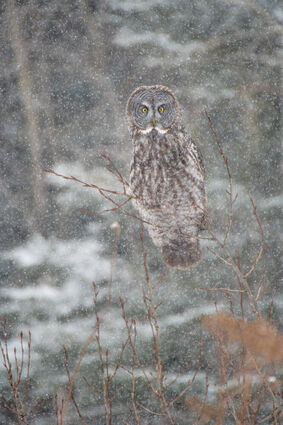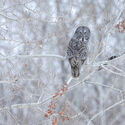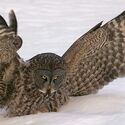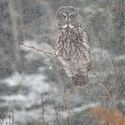Birdwatching: Great grays seeking Great Grays
February 12, 2021

Sparky Stensaas
Great gray owls can hear a vole under two feet of snow at a hundred yards. Photo courtesy of Sparky Stensaas/ThePhotoNaturalist.com
With indoor venues closed for several months, my outdoor companion, Keith, and I have ramped up our birdwatching adventures. We have noticed an increase in birders as others flock to the northeast region of the state seeking the secret spots where others have recorded great sightings.
We have been birding casually for several years, driving and gawking around the region.
The great gray owl is a fun find, and we count on seeing at least one every winter when they are easier to spot in leafless trees. At 27 inches tall, they are the tallest owl in the world, but they are not the heavyweight champs. Underneath all those feathers, this wise bird weighs in at only 2½ pounds. These dapper owls in their gray suits are found in forests across Canada. They are found in northern Minnesota with occasional sightings in northern Wisconsin or Michigan. A sudden increase in their numbers is called an irruptive year, and often indicates that their prey food is in abundance. One owl can eat up to seven vole-sized critters in one day to sustain itself. We have been looking this winter, to no avail, to add it to our annual list. Although they are big, the great grays can be elusive.
We had searched all the likely spots, but our timing was off. Knowing that the great gray is mainly crepuscular and hunts at dawn and dusk, we focused our search in morning and late afternoon, to no avail. No sooner would we get home from a birding excursion, than the phone would ding with an e-bird alert showing a photo of the yellow-eyed predator near a site we had just visited. Now that we are past the 60 mark in years, we dubbed ourselves as great grays seeking great grays, and headed to the Sax Zim bog.
The bog is a 300-square-mile area of spruce bogs, intermixed with highland area, about 40 miles northwest of Cloquet. It is a patchwork of private and public lands that has become a hot spot for birders in search of winter birds.
Dedicated birders have spied on birds in the Sax Zim area for many decades. In 2010, a few Duluth birders discussed forming a nonprofit to help protect and promote the area for others to enjoy. In 2011, the Friends of the Sax Zim Bog was officially formed, and has steadily gained membership. The group purchased parcels of land, and also built a small visitor center that is open mid-December to mid-March and serves as a hub for information.
The small parking lot is often full as bird enthusiasts swap stories about great sightings and camera equipment. The visitor center boasts a spread of suet, sunflower, safflower and thistle seed feeders to reward the hungry birds who dare to expose themselves to eager eyes and camera lenses. Dues and donations from Friends of the Bog and visitors keep the feeders full, and the hopeful gawkers coming.
It is as interesting to watch the watchers as it is the birds. They are a diverse group, coming from states near and far. This winter, we have noted vehicles hailing from Texas, Georgia, Kentucky, Montana, Ohio, New York, Illinois, Wisconsin and both Dakotas. Listening to the tales of feathered findings can give one a slight twang of "list envy," which motivated us to keep roaming the crisscross of rural roads, many bearing names of the Finns who took up residence in the area in bygone years.
We drove the roads of the Sax Zim area, stopping to walk in the Bob Russell and Warren Nelson memorial bogs. These, and other dedicated areas, commemorate passionate birders who frequented the area for years knowing of the hidden wealth of winter birds. Some private residents contribute to the effort by placing feeders and inviting drivers to have a look.
First-time visitors may find birding here confusing and vague, so the bog Friends has a printable map on its website to guide rookies (and veterans) to the feeding sites. Visit their website at saxzim.org for the map and lots of other information along with membership options.
We got skunked that day, and we continue as great grays in search of great grays this winter.

Sparky Stensaas
The great grey owl is a fun find, and we count on seeing at least one every winter when they are easier to spot in leafless trees. At 27 inches tall, they are the tallest owl in the world. Photo courtesy of Sparky Stensaas/ThePhotoNaturalist.com
Ruth Reeves, a former journalist, naturalist and Community Ed director. Email her at news@Pine KnotNews.com
*********
Go and Do
The Sax Zim bog is about 40 miles north and west of Cloquet and a wonderful and adventurous spot to go bird watching. But birds are everywhere, so travel is not necessary. Regular binoculars are great for birding. Always respect posted signs and never trespass on private land. If you do go to the Sax Zim, be aware that the bog boardwalks can be slippery with ice and packed snow. Snowshoes are a great way to get off the boardwalk and deeper into the woods. Find out more at saxzim.org.
Also the Cloquet Public Library is sponsoring a "Birdwatching 101" Zoom presentation at 10 a.m. Friday, Feb. 9. See.cloquetlibrary.org for more.
For more owl photos and video, visit Pine KnotNews.com












